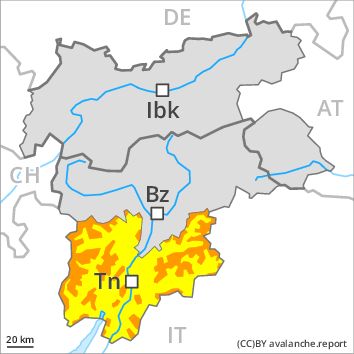Regions
Latemar, Southern Adamello, Primiero - Pale di S. Martino, Adamello - Presanella, Prealps, Northern Brenta - Peller, Cembra Valley, Bondone and Stivo, Vallarsa, Western Nonsberg Alps, Folgaria - Laverone, Southern Brenta, Fassa Valley, Sole, Pejo and Rabbi, Southern Lagorai, Ledro Valley, Northern Lagorai, Maddalene, Paganella, Marzola - Valsugana, Pine' - Mocheni Valley

Danger level
Avalanche Problem
Wind-drifted snow above the treeline, N-NE-E-SE-S-SW-W-NW

Slight increase in danger as a consequence of the snowfall.
As a consequence of fresh snow and a strong southwesterly wind, further wind slabs will form as the day progresses, in particular in gullies and bowls, and behind abrupt changes in the terrain at high altitudes and in high Alpine regions in all aspects. Even single winter sport participants can release avalanches, including large ones. The avalanche prone locations are barely recognisable because of the poor visibility.
Avalanches can in isolated cases be released in the old snowpack. Weak layers in the old snowpack can be released in isolated cases in particular at transitions from a shallow to a deep snowpack. Whumpfing sounds and the formation of shooting cracks when stepping on the snowpack indicate the danger.
Snowpack
dp 6: cold, loose snow and wind
Over a wide area 5 to 10 cm of snow. will fall. The strong wind will transport the snow. The fresh snow and wind slabs are lying on soft layers in all aspects. In some cases the various wind slabs have bonded still only poorly with each other and the old snowpack. The snowpack will be subject to considerable local variations. Large-grained weak layers exist in the old snowpack in particular on steep shady slopes.
Tendency
Slight increase in danger of moist avalanches as a consequence of solar radiation.